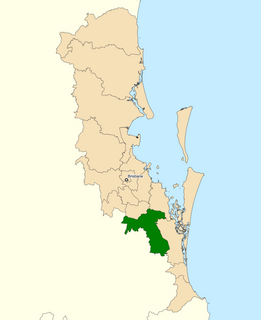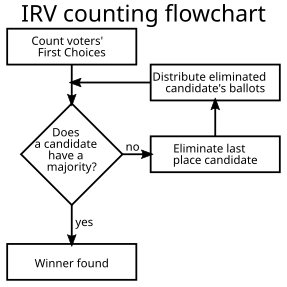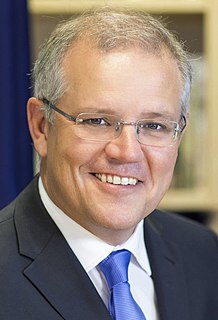
The Country Liberal Party (CLP), officially the Country Liberals , is a liberal conservative political party in Australia founded in 1974, which operates solely in the Northern Territory, however due to Christmas Island and the Cocos (Keeling) Islands forming part of the Division of Lingiari they also vote for the Country Liberal Party.

The Liberal Party of Australia is a major centre-right political party in Australia, one of the two major parties in Australian politics, along with the centre-left Australian Labor Party (ALP). It was founded in 1944 as the successor to the United Australia Party (UAP).
The National Party of Australia, also known as The Nationals or The Nats, is an Australian political party. Traditionally representing graziers, farmers, and rural voters generally, it began as the Australian Country Party in 1920 at a federal level. It would later briefly adopt the name National Country Party in 1975, before adopting its current name in 1982.

The 2001 Australian federal election was held in Australia on 10 November 2001. All 150 seats in the House of Representatives and 40 seats in the 76-member Senate were up for election. The incumbent Liberal Party of Australia led by Prime Minister of Australia John Howard and coalition partner the National Party of Australia led by John Anderson defeated the opposition Australian Labor Party led by Kim Beazley.

The premiers and chief ministers of the Australian states and territories are the heads of the executive governments in the six states and two self-governing territories of the Commonwealth of Australia. They perform the same function at the state and territory level as the Prime Minister of Australia performs at the national level. The territory equivalents to the premiers are the chief ministers of the Northern Territory and the Australian Capital Territory. The Queen of Australia and the state governors are the formal repositories of executive power; however, in practice they act only on the advice of state premiers and ministers except in extreme circumstances.
James Eric Lloyd, Australian politician, was a Liberal Party of Australia member of the Australian House of Representatives from the March 1996 election until the November 2007 election, representing the Division of Robertson in New South Wales.

The Australian Electoral Commission (AEC) is the independent federal agency in charge of organising, conducting and supervising federal elections, by-elections and referendums.

Elections in Australia take place periodically to elect the legislature of the Commonwealth of Australia, as well as for each Australian state and territory. Elections in all jurisdictions follow similar principles, though there are minor variations between them. The elections for the Australian Parliament are held under the federal electoral system, which is uniform throughout the country, and the elections for state and territory Parliaments are held under the electoral system of each state and territory.

The Liberal–National Coalition, commonly known simply as The Coalition, is an alliance of centre-right political parties that forms one of the two major groupings in Australian federal politics. Its main opponent is the Australian Labor Party (ALP); the two forces are often regarded as operating in a two-party system. The Coalition has been in government since the 2013 federal election, most recently being re-elected in the 2019 Australian federal election. The group is led by Scott Morrison as Prime Minister of Australia since August 2018.

The Division of Forde is an Australian Electoral Division in Queensland.

The Division of Curtin is an Australian electoral division in Western Australia.

The Liberal Party of Australia , commonly known as the New South Wales Liberals, is the state division of the Liberal Party of Australia in New South Wales. The party currently governs in New South Wales in coalition with the National Party of Australia (NSW). The party is part of the federal Liberal Party which governs nationally in Coalition with the National Party of Australia.

The Liberal Democratic Party is an Australian political party founded in Canberra in 2001. The party espouses smaller government and supports policies that are based on classical liberal and right-libertarian principles. The LDP is a registered party in the Australian Capital Territory, New South Wales, South Australia, Victoria and Western Australia and is also registered for federal elections with the Australian Electoral Commission. It also has a member of the Western Australian Legislative Council, Aaron Stonehouse, two representatives in the Victorian Legislative Council, Tim Quilty and David Limbrick, and elected representatives in some local governments.

The politics of Australia take place within the framework of a federal parliamentary constitutional monarchy. Australia has maintained a stable liberal democratic political system under its Constitution, one of the world's oldest, since Federation in 1901. Australia is the world's sixth oldest continuous democracy and largely operates as a two-party system in which voting is compulsory. The Economist Intelligence Unit rated Australia a "full democracy" in 2019. Australia is also a federation, where power is divided between the federal government and the states and territories.
The Young Liberal Movement of Australia, commonly referred to as the Young Liberals, is the youth movement of the Liberal Party of Australia representing Liberal members aged 16 to 31. The Movement is organised as a federation with each state and territory division responsible for their own campaigns, policy platform and strategic direction.

In Australian politics, the two-party-preferred vote is the result of an election or opinion poll after preferences have been distributed to the highest two candidates, who in some cases can be independents. For the purposes of TPP, the Liberal/National Coalition is usually considered a single party, with Labor being the other major party. Typically the TPP is expressed as the percentages of votes attracted by each of the two major parties, e.g. "Coalition 50%, Labor 50%", where the values include both primary votes and preferences. The TPP is an indicator of how much swing has been attained/is required to change the result, taking into consideration preferences, which may have a significant effect on the result.
The Progress Party was a minor Australian political party in the mid-to-late 1970s. Initially known as the Workers Party, it was formed on Australia Day 1975 as a free market libertarian and anti-socialist party by businessmen John Singleton and Sinclair Hill in reaction to the economic policies of Labor prime minister Gough Whitlam. It operated and ran candidates in Western Australia, Northern Territory, South Australia, Queensland and New South Wales, but did not have a central federal structure and its Western Australian affiliate, which additionally advocated secession from the rest of Australia, did particularly well in the area surrounding Geraldton in the State's Mid West. However the party failed to win seats at any level of government, and passed out of existence by 1981.

The 2019 Australian federal election was held on Saturday 18 May 2019 to elect members of the 46th Parliament of Australia. The election had been called following the dissolution of the 45th Parliament as elected at the 2016 double dissolution federal election. All 151 seats in the House of Representatives and 40 of the 76 seats in the Senate were up for election.

The next Northern Territory general election, which is scheduled for 22 August 2020, will elect members of the Legislative Assembly in the unicameral Northern Territory Parliament of Northern Territory, Australia. All 25 seats in the Legislative Assembly whose current members were elected at the 2016 election will become vacant. Members will be elected through full preferential instant-runoff voting in single-member electorates, after the optional preferential voting system introduced for the 2016 election was abolished by the Electoral Legislation Amendment Act 2019 in April 2019. The election will be conducted by the Northern Territory Electoral Commission, an independent body answerable to Parliament. The incumbent centre-left Labor Party (ALP) majority government, led by Chief Minister Michael Gunner will attempt to win a second term of government, and will be challenged by the centre-right Country Liberal Party (CLP) opposition, led by Opposition Leader Lia Finocchiaro.













